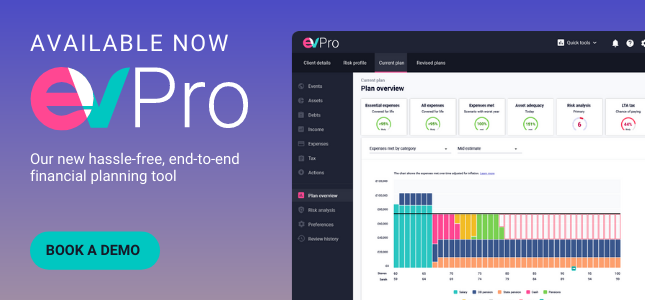The significance of choosing sustainable income funds in drawdown

In our latest blog, we discover why it’s important for your clients to have a sustainable level of income when entering drawdown and how you can help your clients choose the right funds to meet their income needs for life.
Few financial decisions carry greater importance to your client than selecting how to draw their defined contribution pension benefits. And your role in helping them choose the correct product and/or strategy is paramount to ensuring their income needs remain met for the duration of retirement.
As we know, consumers are presented with two main options here: guaranteed income through an annuity purchase or flexible income via drawdown. Although not a binary choice, a combination of the two can often be prudent, yet most tend to favour one over the other.
And while each has its own merits, since the Pension Freedoms were introduced in 2015, flexible income has become the popular choice.
Retirement Income Market Data
According to the latest FCA’s Retirement Income Market data, the total number of pension plans accessed by consumers for the first time in 2019/20 increased by 3% to 674,000 compared to 2018/19 (652,000).
Annuity purchases declined by 6% to 69,500 in 2019/20. While pension plans entering income drawdown increased by 1.5% to 197,118 in 2019/20 compared to 2018/19 (194,158).
Interestingly, 36% of consumer pension plans accessed for the first time in 2019/20 were accessed by plan holders who took regulated advice (no change from 2018/19). Which leaves a staggering 64% of consumers making life-defining financial decisions on their own.
Income at Risk
For those clients opting for drawdown, the decision-making process is only just getting started. There is a myriad of investment options for you and your clients to navigate to ensure that any strategy puts them in the best possible position of achieving their retirement objectives.
This is one of the key factors behind the increasing popularity of drawdown – consumers crave control over how they draw their pension savings. Lifetime annuities remain an essential consideration in the advice process. Still, rigidity and less favourable death benefits have dropped them down the pecking order. Investors want flexibility and are prepared to accept the more significant risks that come with it.
The nature of drawdown means the chosen investment strategy can and should be reviewed and amended regularly. But still, given some of the most significant risks to a drawdown pot lasting the distance, such as pound cost ravaging and sequencing of returns, occur in the first few years of retirement. Selecting the right strategy at the outset is crucial. It should differ from your approach typically used for accumulation, as clients are looking for sustainable income instead of capital growth.
For this reason, it’s important to analyse income and capital through different lenses. And that’s why we’ve developed a new risk-rated system that applies greater precision in measuring risk when income is your client’s objective.
Income Risk-Ratings
Our income risk-rating of funds is a standard and transparent approach, measuring a fund’s income-at-risk, and has been designed to provide much-needed consistency to selecting funds in decumulation, complementing your other processes around cashflow withdrawal planning.
Each of the funds reviewed is allocated a risk rating from one to five, one to seven, or one to 10. The outcome from the income risk questionnaire is then matched with a suitable fund, representing a genuinely in-depth approach. The risk rating is based on 10,000 future forecasts from our economic scenario generator, arming you with the necessary information to ascertain which funds to recommend for your clients.
This information includes;
- the risk level of a fund on an entirely consistent basis to other funds;
- how good the fund is at delivering income relative to additional funds in its peer group by comparing median incomes before charges;
- calculating the potential for a fall in the level of income that a client could realistically expect if the level of income drawn remained unchanged for three years before being reviewed.
Deliver a Sustainable Income with the right Asset-allocations
The implications for choosing the wrong underlying assets within a retirement income can be severe. Historically, fixed income securities were a common and favoured asset class due to a combination of solid income generation and greater capital security than equities.
However, since the 2008 global financial crisis, interest rates have remained at record lows, meaning large allocations to fixed interest assets such as government and corporate bonds are unlikely to generate the required level of sustainable income that they once did.
Unlike drawdown investors, annuity holders benefit from the pooling of longevity risk, and specifically mortality cross-subsidy—those clients who outlive average life expectancy benefit at the expense of those who die sooner. The annuity rate agreed at inception unless selected on a joint-life basis will be paid until the annuitant dies, whenever that occurs.
As people age, with each passing year, the combination of them drawing from their pot and deferring buying an annuity means potentially missing out on mortality cross-subsidy. This accelerates with age, meaning the equivalent required growth rate from a drawdown plan rises with every passing year.
Far from suggesting that those who live a long and healthy life would be better off buying an annuity, the key point to be made here is that drawdown customers must ensure that their fund is providing a sustainable income and sustaining its capital value.
This will help your clients safely avert mortality drag, demonstrated by considering how much a pension drawdown fund must grow for each year that someone defers buying an equivalent annuity.
This indeed underlines the importance of applying a rigorous approach to ascertaining a fund’s income at risk. Our income risk-rated system helps lay the groundwork for your drawdown clients to live a financially comfortable retirement from start to finish.
So what next?
We feel this marks a critical step in the suitability advice journey to making sure recommended funds are aligned to investor risk appetite. Consumer behaviour has shifted considerably since Pension Freedoms. With more retirees favouring drawdown, we will continue arming you with the right tools to support these changing client needs.
